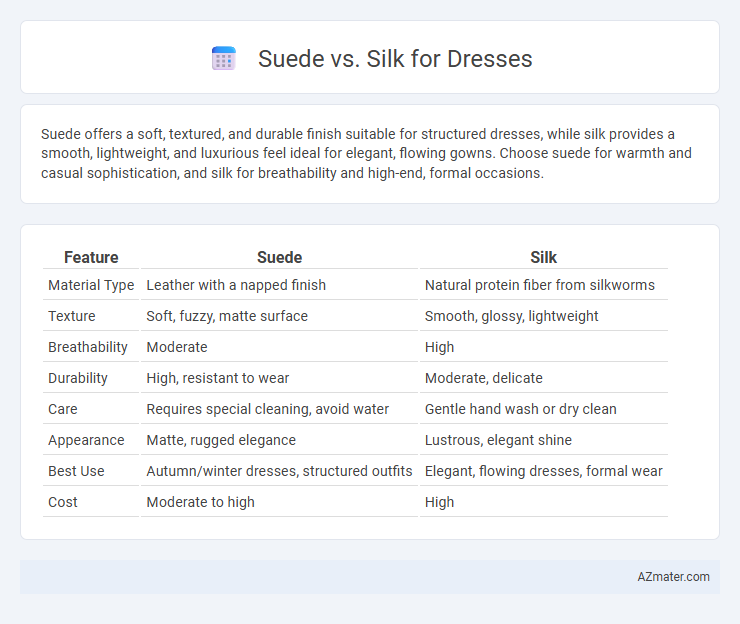Suede offers a soft, textured, and durable finish suitable for structured dresses, while silk provides a smooth, lightweight, and luxurious feel ideal for elegant, flowing gowns. Choose suede for warmth and casual sophistication, and silk for breathability and high-end, formal occasions.
Table of Comparison
| Feature | Suede | Silk |
|---|---|---|
| Material Type | Leather with a napped finish | Natural protein fiber from silkworms |
| Texture | Soft, fuzzy, matte surface | Smooth, glossy, lightweight |
| Breathability | Moderate | High |
| Durability | High, resistant to wear | Moderate, delicate |
| Care | Requires special cleaning, avoid water | Gentle hand wash or dry clean |
| Appearance | Matte, rugged elegance | Lustrous, elegant shine |
| Best Use | Autumn/winter dresses, structured outfits | Elegant, flowing dresses, formal wear |
| Cost | Moderate to high | High |
Introduction: Comparing Suede and Silk Dresses
Suede dresses offer a rich, textured appearance with a soft, matte finish that provides durability and a casual yet sophisticated style. Silk dresses, known for their smooth, lustrous fabric, offer elegance, breathability, and a lightweight feel perfect for formal occasions. Choosing between suede and silk depends on the desired look, season, and comfort preferences, with suede excelling in cooler weather and silk favored for its luxurious drape and temperature regulation.
Fabric Overview: What is Suede?
Suede is a type of leather made from the underside of animal hides, primarily lamb, goat, or calf, known for its soft, napped finish and supple texture. Unlike smooth leather, suede has a fuzzy surface created by sanding the inner layer, offering a matte appearance and excellent breathability. Its durability and luxurious feel make suede a popular choice for stylish dresses that combine comfort with a refined, textured look.
Fabric Overview: What is Silk?
Silk is a natural protein fiber produced by silkworms, renowned for its smooth texture, lightweight feel, and lustrous sheen. This luxurious fabric is highly breathable and hypoallergenic, making it ideal for elegant dresses that require a soft drape and a glossy finish. Unlike suede, silk offers superior moisture-wicking properties and a delicate, shimmering appearance, perfect for formal and evening wear.
Comfort and Wearability: Suede vs Silk
Suede offers a soft, durable texture that provides warmth and breathability, making it suitable for cooler weather dresses with a comfortable, structured fit. Silk boasts a smooth, lightweight texture that excels in moisture-wicking and temperature regulation, ideal for elegant, breathable dresses in warmer climates. Both materials enhance comfort and wearability differently, with suede favored for resilience and silk preferred for luxurious softness.
Aesthetic Appeal: Texture, Color, and Shine
Suede offers a rich, matte texture with a soft, velvety feel that enhances a dress's tactile appeal, creating a warm and sophisticated look. Silk provides a smooth, glossy surface with a natural sheen that reflects light beautifully, giving dresses an elegant and luxurious appearance. Color depth in suede is typically muted and earthy, while silk allows for vibrant, luminous hues due to its fine, reflective fibers.
Durability and Longevity of Each Fabric
Suede offers moderate durability with a soft texture that can withstand daily wear if properly maintained, but it is prone to staining and water damage, reducing its longevity. Silk provides a delicate, luxurious feel with high tensile strength, yet it is susceptible to snags, fading, and requires careful laundering to preserve its lifespan. Both fabrics demand specific care routines, with suede benefiting from water repellents and silk requiring gentle cleaning to maximize durability and maintain appearance over time.
Seasonality: Best Occasions for Suede or Silk Dresses
Suede dresses excel in fall and winter due to their insulating properties and textured, luxurious appearance, making them ideal for cooler weather events like evening parties and outdoor gatherings. Silk dresses are perfect for spring and summer occasions because of their breathable, lightweight fabric and elegant drape, fitting well with formal events, weddings, and daytime functions. Choosing between suede and silk depends on seasonal comfort and the occasion's dress code, with suede suited for warmth and casual elegance, while silk offers sophistication and coolness.
Care and Maintenance Requirements
Suede dresses require delicate care involving specialized suede brushes and avoid exposure to water to maintain texture and prevent damage. Silk dresses need gentle hand washing with mild detergent or dry cleaning to preserve their smooth, lustrous finish and prevent fabric weakening. Both fabrics demand careful storage away from direct sunlight and humidity to extend garment longevity and retain material quality.
Sustainability and Ethical Considerations
Suede and silk differ significantly in sustainability and ethical considerations; suede, often derived from animal hides, raises concerns about animal welfare and the environmental impact of leather tanning processes, which can involve toxic chemicals. Silk, produced from silkworms, generally has a lower carbon footprint but involves ethical debates around the harvesting of larvae, although processes like Ahimsa silk aim to mitigate this by allowing moths to emerge alive. Choosing sustainable dress materials depends on the sourcing transparency, production methods, and innovations promoting cruelty-free and eco-friendly practices in both suede and silk industries.
Final Verdict: Choosing Between Suede and Silk
Suede offers a textured, durable option ideal for structured dresses and cooler weather, while silk provides a smooth, lightweight fabric perfect for elegant, flowing designs and warm climates. Dress designers prioritize suede for its matte finish and warmth, contrasting with silk's natural sheen and breathable qualities that enhance comfort. The final choice hinges on desired dress aesthetics, seasonality, and maintenance preferences, with suede excelling in rugged sophistication and silk favored for luxury and softness.

Infographic: Suede vs Silk for Dress
 azmater.com
azmater.com